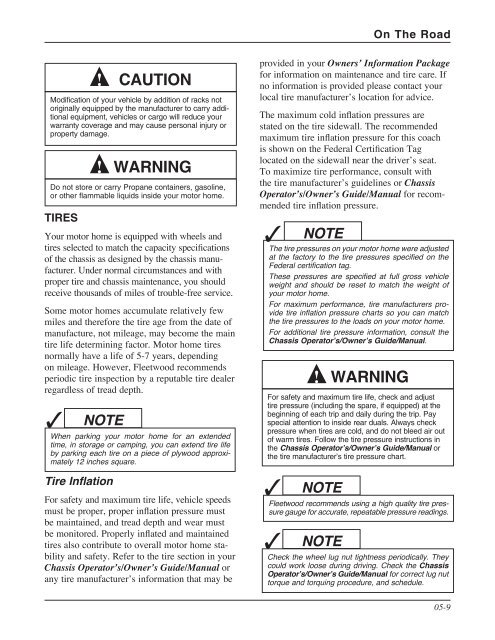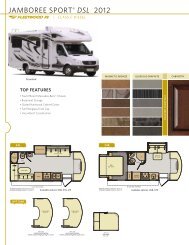You also want an ePaper? Increase the reach of your titles
YUMPU automatically turns print PDFs into web optimized ePapers that Google loves.
TIRES<br />
Your motor home is equipped with wheels and<br />
tires selected to match the capacity specifications<br />
of the chassis as designed by the chassis manufacturer<br />
. Under normal circumstances and with<br />
proper tire and chassis maintenance, you should<br />
receive thousands of miles of trouble-free service .<br />
Some motor homes accumulate relatively few<br />
miles and therefore the tire age from the date of<br />
manufacture, not mileage, may become the main<br />
tire life determining factor . Motor home tires<br />
normally have a life of 5-7 years, depending<br />
on mileage . However, <strong>Fleetwood</strong> recommends<br />
periodic tire inspection by a reputable tire dealer<br />
regardless of tread depth .<br />
3<br />
!<br />
!<br />
NOTE<br />
Tire Inflation<br />
CAUTION<br />
Modification of your vehicle by addition of racks not<br />
originally equipped by the manufacturer to carry additional<br />
equipment, vehicles or cargo will reduce your<br />
warranty coverage and may cause personal injury or<br />
prop erty damage.<br />
WARNING<br />
Do not store or carry Propane containers, gasoline,<br />
or other flammable liquids inside your motor home.<br />
When parking your motor home for an extended<br />
time, in storage or camping, you can extend tire life<br />
by parking each tire on a piece of plywood approximately<br />
12 inches square.<br />
For safety and maximum tire life, vehicle speeds<br />
must be proper, proper inflation pressure must<br />
be maintained, and tread depth and wear must<br />
be monitored. Properly inflated and maintained<br />
tires also contribute to overall motor home stability<br />
and safety . Refer to the tire section in your<br />
Chassis Operator’s/Owner’s Guide/Manual or<br />
any tire manufacturer’s information that may be<br />
On The Road<br />
provided in your Owners’ Information Package<br />
for information on maintenance and tire care . If<br />
no information is provided please contact your<br />
local tire manufacturer’s location for advice .<br />
The maximum cold inflation pressures are<br />
stated on the tire sidewall . The recommended<br />
maximum tire inflation pressure for this coach<br />
is shown on the Federal Certification Tag<br />
located on the sidewall near the driver’s seat .<br />
To maximize tire performance, consult with<br />
the tire manufacturer’s guidelines or Chassis<br />
Operator’s/Owner’s Guide/Manual for recommended<br />
tire inflation pressure.<br />
3<br />
3<br />
NOTE<br />
The tire pressures on your motor home were adjusted<br />
at the factory to the tire pressures specified on the<br />
Federal certification tag.<br />
These pressures are specified at full gross vehicle<br />
weight and should be reset to match the weight of<br />
your motor home.<br />
For maximum performance, tire manufacturers provide<br />
tire inflation pressure charts so you can match<br />
the tire pressures to the loads on your motor home.<br />
For additional tire pressure information, consult the<br />
Chassis Operator’s/Owner’s Guide/Manual.<br />
NOTE<br />
<strong>Fleetwood</strong> recommends using a high quality tire pressure<br />
gauge for accurate, repeatable pressure readings.<br />
3<br />
!<br />
NOTE<br />
WARNING<br />
For safety and maximum tire life, check and adjust<br />
tire pressure (including the spare, if equipped) at the<br />
beginning of each trip and daily during the trip. Pay<br />
special attention to inside rear duals. Always check<br />
pressure when tires are cold, and do not bleed air out<br />
of warm tires. Follow the tire pressure instructions in<br />
the Chassis Operator’s/Owner’s Guide/Manual or<br />
the tire manufacturer’s tire pressure chart.<br />
Check the wheel lug nut tightness periodically. They<br />
could work loose during driving. Check the Chassis<br />
Operator’s/Owner’s Guide/Manual for correct lug nut<br />
torque and torquing procedure, and schedule.<br />
05-9






